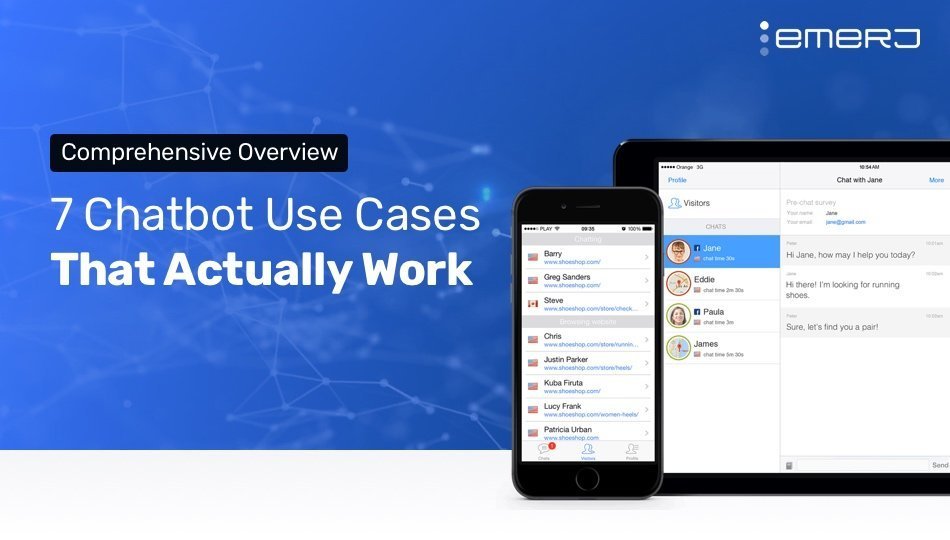Since Facebook Messenger, WhatsApp, Kik, Slack, and a growing number of bot-creation platforms came online, developers have been churning out chatbots across industries, with Facebook’s most recent bot count at over 33,000. At a CRM technologies conference in 2011, Gartner predicted that 85 percent of customer engagement would be fielded without human intervention. Though a seeming natural fit for retail and purchasing-related decisions, it doesn’t appear that chatbot technology will play favorites in the coming few years, with uses cases being promoted in finance, human resources, and even legal services.
Not all chatbots are created equal though; some catch on while others fall away just as quick, and the level of function and natural interaction varies widely. Some companies (see #7 in this list) even argue for semantics i.e. “virtual assistant” is a more robust and advanced technology than a chatbot.
In this article, we shed a spotlight on 7 real-world chatbots/virtual assistants across industries that are in action and reaping value for their parent companies. From streamlined operations and saved human productivity to increased customer engagement, the following examples are worth a read if you’ve ever considered leveraging chatbot technology for your business (or are curious about the possibilities).
Each example is broken down into company description, chatbot/virtual assistant design and purpose, value proposition (tangible business results), and key questions/takeaways to consider when thinking about how to apply technology to your own company or industry.

1 – Expensify: “Concierge” 
Company Description: Expensify software helps streamline and automate expense reports and travel arrangements for companies across industries.
How it’s being used:
- Concierge takes new users step-by-step through the setup process, and is designed to proactively trouble-shoot customer issues (for example, if the connection between a user’s credit card and Expensify is severed, the chatbot gives instructions on how to fix the connection before it becomes a problem)
- With access to real-time travel pricing, Concierge is able to notify users if they’re receiving the best value
- Concierge can communicate with users on Expensify’s website or via mobile and is compatible with Slack (the cloud-based team collaboration tool)
Value proposition:
- In an interview with FastCompany, Barrett noted that Concierge has helped reduce banking problems by 75%, and that the website has quintupled the number of its free trials (Expensify has no shortage of big-name clients, which include Uber, Warby Parker, Virgin Hotels, and Quora, to name a select handful).
Key questions/takeaways:
Select quotes are borrowed from FastCompany’s interview with CEO David Barrett:
- Are there recurring customer service issues or problem areas in our business that would benefit from preventive interaction? CEO David Barrett stated , “You don’t want to talk to the chatbot, you want something to happen with the minimum amount of interaction.”
- How might our business help customers make better and quicker decisions? Barrett advises keeping the user interface simple: “People don’t want more functionality, they already have too much functionality. The most modern applications today are about having less UI, a single button that does a tremendous amount…”
2 – 1-800-Flowers: “GWYN” 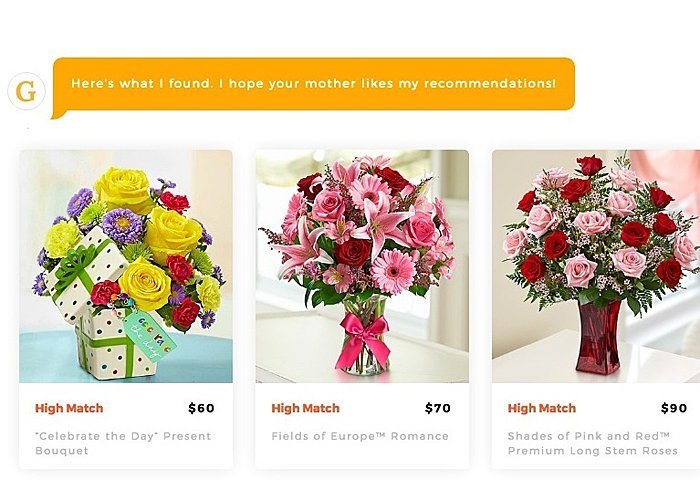
Company description: A floral and gourmet foods gift retailer and distribution company and one of the first businesses to use telephone and Internet for direct sales.
How it’s being used:
- GWYN is a product of IBM’s artificial intelligence system, Watson, and is based on the Fluid Expert Personal Shopper (XPS) software platform); the chatbot helps consumers search for and place their gift order online
- GWYN becomes smarter as “she” interacts with more customers over time; the eventual goal is to offer a customized shopping experience based on a user’s past buying behaviors
- Using natural language, GWYN interprets customer questions about a product or service; “she” can then follow up with additional questions about the intended audience, occasion, and sentiment in order to suggest best-fit gifts for a particular customer
Value proposition:
- 1-800-Flowers’ 2017 first quarter results showed total revenues had increased 6.3 percent to $165.8 million, with the Company’s Gourmet Food and Gift Baskets business as a significant contributor. CEO Chris McCann stated, “…our Fannie May business recorded positive same store sales as well as solid eCommerce growth, reflecting the success of the initiatives we have implemented to enhance its performance.” While McCann doesn’t go into specifics, we assume that initiatives include the implementation of GWYN, which also seems to be supported by CB Insights’ finding: 70% of customers ordering through the chat bot were new 1-800-Flowers customers as of June 2016.
Key takeaways:
- How can we encourage additional customer purchases while they shop? Train a system to “read a customer’s mind” by gathering key information points and intuiting complimentary products and services. Use chatbots to help personalize the customer experience and invite return purchases, increasing customer lifetime value.
3 – LV=Broker: *“aLVin”
Company description: LV= is a UK-based provider of financial products and services; its LV=Broker division offers a range of commercial and personal lines products for third-party brokers.
How it’s being used:
- aLVin is built on the foundation of Nuance’s Nina, the intelligent multichannel virtual assistant that leverages natural language understanding (NLU) and cognitive computing capabilities. aLVin interacts with brokers to better understand “intent” and deliver the right information 24/7; the chatbot was built with extensive knowledge of LV=Broker’s products, which accelerated the process of being able to answer more questions and direct brokers to the right products early on
- aLVin’s live chat service overlaps when needed with human support representatives. Over time, LV= envisions a more collaborative relationship between the virtual assistant and the human support agents, which will help increase the number of transactional tasks that aLVin can assist with and allow service agents to handle more complex tasks
Value proposition:
Select quotes are borrowed from Computing’s interview with Head of Personal Lines Operations Alan Hickman.
- Alan Hickman noted that after the pilot, 98% of brokers said that they would use the service if offered full-time.
- LV= also benefitted as a larger company. According to Hickman, “Over the (trial) period, the volume of calls from broker partners reduced by 91 per cent…that means is aLVin was able to provide a final answer in around 70 per cent of conversations with the user, and only 22 per cent of those conversations resulted in [needing] a chat with a real-life agent.”
Key takeaways:
- How can our business streamline tasks for professionals in a target industry? LV=’s Broker division wanted to be able to deliver important information conveniently to brokers 24/7.
- Are there areas where we could automate simpler customer requests (frequently asked questions/tasks) and reserve human capital for more sensitive or complicated demands?
*Our search turned up little recent information (the chatbot was introduced in June 2015), and while aLVin appeared to be a fruitful addition, it’s unclear “he” or a successor are still in use by LV=
4 – H&M: The Official H&M Chatbot 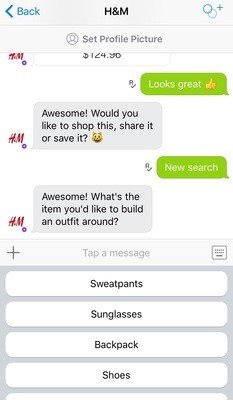
Company Description: H&M is a global fashion company that promote sustainable materials and human labor
How it’s being used:
- The purpose of H&M’s chatbot is to help mobile customers navigate their search through outfit possibilities and guide you to the online store areas that align with your purchase desires.
- H&M’s chatbot leverages the following information and responds differently based on provided information:
- Defines your gender and style
- Suggests outfits and the total price for all items
- If you dislike the suggested outfit, the chatbot will select a different outfit
- If you like the outfit, the chat provides some options: shop – direct link to the H&M internet shop; save – archive your outfit; share – via social networks, email, etc.; next outfit – provides a new outfit suggestion
Value proposition:
- H&M’s consistent increased sales over the past year and its August announcement to launch an eCommerce presence in Canada and South Korea during the fall of 2016, along with 11 new H&M online markets (for a total of 35 markets by the end of the year), appear to signify positive results for its chatbot implementation (though direct correlations are unavailable on its website).
Key takeaways:
- How can our business leverage technology to better and more often engage younger audiences with our products and services? H&M is one of several retailers experimenting with and leveraging chatbots as a mobile marketing opportunity – according to a report by Accenture, 32 percent of the world (a large portion of the population 29 years old and younger) uses social media daily and 80 percent of that time is via mobile.
5 – Amtrak: “Julie” 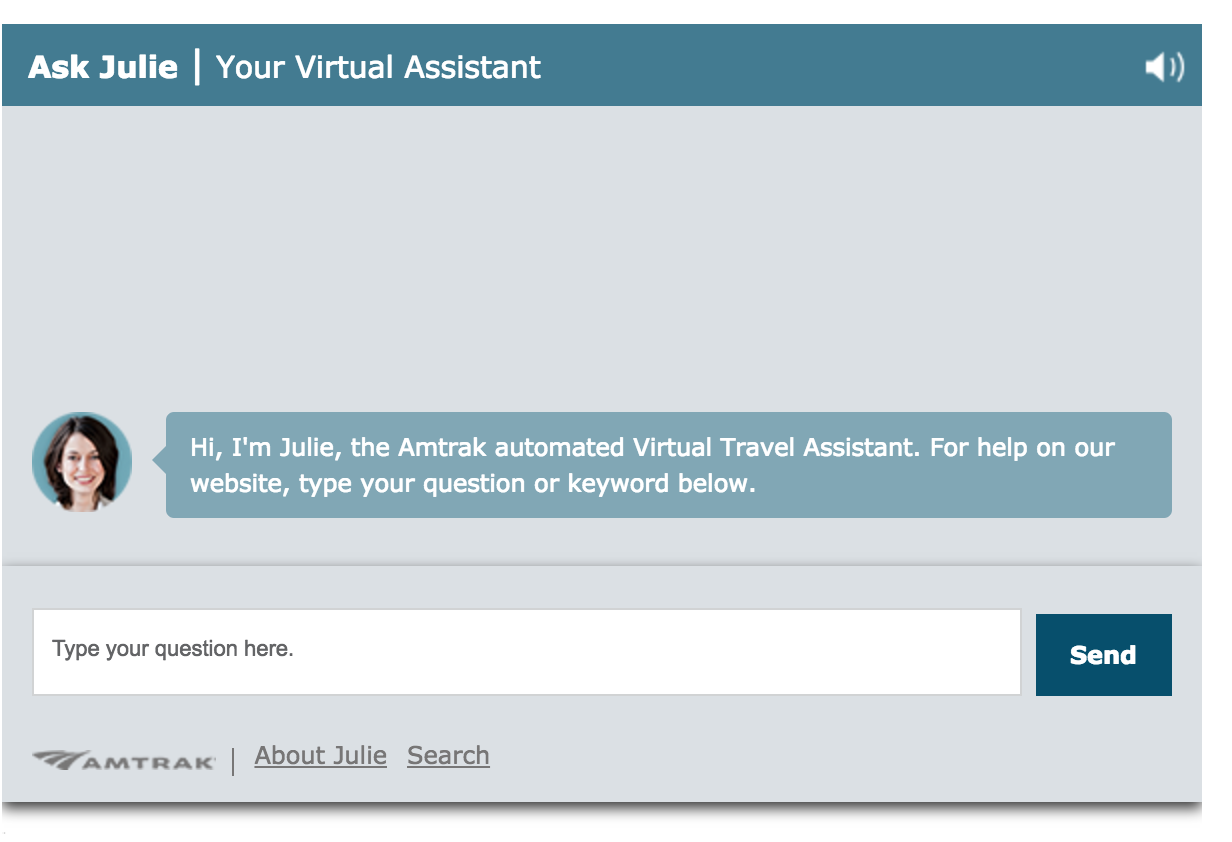
Company description: The National Railroad Passenger Corporation (Amtrak) provides rail passenger services for customers in the 48 contiguous U.S. states.
How it’s being used:
- Julie, a newer version of Amtrak’s original telephone-based customer service agent, is designed to guide users through Amtrak.com using natural language capabilities and a broad knowledge-base of the site
- In addition to responding through text, Julie can vocalize “her” answer alongside a written response
- Julie can provide or help customers find information on making a reservation, getting more information on Amtrak’s rewards program, finding station and route information, and a variety of other areas
Value proposition:
- According to nextIT (Julie’s product platform), implementation of Julie resulted in the following:
- 25 percent more bookings
- $1 million in customer service email costs saved annually
- 50 percent year-over-year growth in users’ engagement with Julie
- 30 percent more revenue (monthly average) generated per booking
Key takeaways:
- Is there a way to evolve or augment existing technology to make it more engaging and useful for customers? Instead of ditching Julie the telephone rep, Amtrak expanded “her” presence by implementing a more responsive chatbot.
- Do the nature of our services and size of our customer base warrant an investment in a more efficient and automated customer service response? How can we offer a more streamlined experience without (necessarily) increasing costly human resources? Amtrak’s website receives over 375,000 daily visitors, and they wanted a solution that provided users with instant access to online self-service.
6 – FirstJob: “Mya” 
Company description: FirstJob is an online-based recruiting firm that matches recent college graduates with entry-level jobs and internships by leveraging their existing social networks.
How it’s being used:
- Mya is an A.I. recruiting assistant that manages large candidate pools, giving FirstJob recruiters and hiring managers more time to focus on interviews and closing offers
- Mya can talk to thousands of candidates at once through SMS, Facebook, Skype, email, or chat
- Mya asks prescreen questions; responds to FAQs; delivers application progress updates; gives tips and guidance to candidates; alerts candidates when a position has been filled; and administers assessments and challenges
- Mya also provides useful information for recruiters and managers, ranking candidates from most qualified to least based on weighted factors like experience, recent activity, engagement, and other metrics
Value proposition:
- According to FirstJob, Mya automates up to 75 percent of the qualifying and engagement process.
- As reported by Forbes, studies suggest that Mya improves recruiter efficiency by 38 percent and increases candidate engagement by over 150 percent.
Key takeaways:
Select quotes are borrowed from Forbes’ interview with CEO and Co-founder Eyal Grayevsky.
- Can we provide a better way of doing business that transforms an arduous “elephant-in-the-room” process or task into one that allows all involved parties to stay active and engaged? As stated by Grayevsky, “I saw a huge opportunity to design a technology platform for both job seekers and employers that could fill the gaping ‘black hole’ in recruitment and deliver better results to both sides.”
7 – TouchCommerce: “TouchAssist” 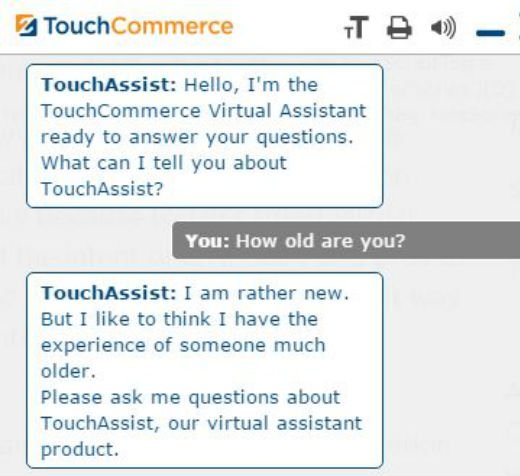
Company description: TouchCommerce serves many Fortune 500 companies with customer engagement tools like livechat and FAQs; the company was acquired by Nuance in August 2016.
How it’s being used:
- TouchAssist’s natural language and cognitive computing capabilities allow it to interact with customers and offer a “self-serve” experience (TouchAssist is consciously referred to by the company as a virtual assistant, not a chatbot)
- A live chat agent is available on standby if TouchAssist is unable to answer a question/provide the appropriate level of service
- TouchAssist leverages existing transcript data and other information from its consumer interactions to continuously improve the usability and user experience
- Virtual assistant and live chat engagements are visible and accessible from the same user window
- TouchAssist is compatible with multiple devices, including desktop, tablet, mobile browser, in-app and SMS
Value proposition:
- TouchAssist responds to repetitive questions, freeing up about 80% of human agents’ time to work on other tasks, and reduces the average handle time of customer interactions overall.
Key takeaways:
- What areas of our customer engagement process could benefit from lessening or eliminating unnecessary human interaction? According to TouchCommerce, 84% of customers polled prefer to use self-service to get what they need.
Image credit: App Developer Magazine


